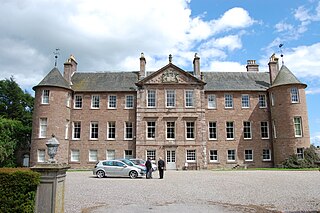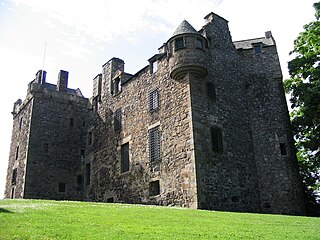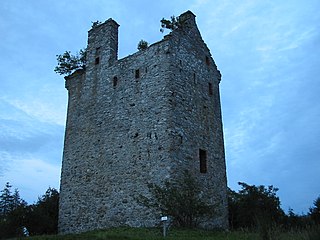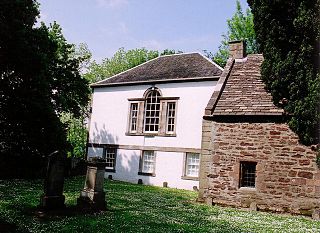

Invermark Lodge is a hunting lodge which was built near Invermark Castle in 1852 for John Ramsay, 13th Earl of Dalhousie. It is now a listed building and continues to be operated as a grouse moor by the Dalhousie family. [1] [2]


Invermark Lodge is a hunting lodge which was built near Invermark Castle in 1852 for John Ramsay, 13th Earl of Dalhousie. It is now a listed building and continues to be operated as a grouse moor by the Dalhousie family. [1] [2]

Brechin Castle is a castle in Brechin, Angus, Scotland. The castle was constructed in stone during the 13th century. Most of the current building dates to the early 18th century, when extensive reconstruction was carried out by architect Alexander Edward for James Maule, 4th Earl of Panmure, between approximately 1696 and 1709. The castle is a 37,748 square feet (3,506.9 m2) Category A listed building and the grounds are included in the Inventory of Gardens and Designed Landscapes in Scotland.

Edzell Castle is a ruined 16th-century castle, with an early-17th-century walled garden. It is located close to Edzell, and is around 5 miles (8 km) north of Brechin, in Angus, Scotland. Edzell Castle was begun around 1520 by David Lindsay, 9th Earl of Crawford, and expanded by his son, Sir David Lindsay, Lord Edzell, who also laid out the garden in 1604. The castle saw little military action, and was, in its design, construction and use, more of a country house than a defensive structure. It was briefly occupied by English troops during Oliver Cromwell's invasion of Scotland in 1651. In 1715 it was sold by the Lindsay family, and eventually came into the ownership of the Earl of Dalhousie. It was given into state care in the 1930s, and is now a visitor attraction run by Historic Environment Scotland. The castle consists of the original tower house and building ranges around a courtyard. The adjacent Renaissance walled garden, incorporating intricate relief carvings, is unique in Scotland. It was replanted in the 1930s, and is considered to have links to esoteric traditions, including Rosicrucianism and Freemasonry.

Maybury is an area on the western edge of Edinburgh, Scotland, near South Gyle and Ingliston, named after the road, which is itself named after the civil engineer Sir Henry Maybury (1864–1943). In 2021, residents have been undertaking community clean ups to clear the foot paths along the road. The area is residential in the north east/east and commercial in the south and west and The Gyle Shopping Centre is nearby. In 2021, there was a consultation about creating a Primary School and Health Centre in Maybury.

Manderston House, Duns, Berwickshire, Scotland, is the home of The Rt Hon. The 4th Baron Palmer. It was completely rebuilt between 1901 and 1903 and has sumptuous interiors with a silver-plated staircase. The proprietor, Sir James Miller, 2nd Baronet (1864–1906), told the architect, John Kinross, that there was no budget: "It doesn't matter". The house is a Category A listed building and the surrounding area, which includes the farm complex at Buxley, is listed in the Inventory of Gardens and Designed Landscapes in Scotland.

The Dugald Stewart Monument is a memorial to the Scottish philosopher Dugald Stewart (1753–1828). It is situated on Calton Hill overlooking the city of Edinburgh and was designed by Scottish architect William Henry Playfair. It was completed in September 1831.

Elcho Castle is located a short distance above the south bank of the River Tay approximately four miles south-east of Perth, Scotland. It consists of a Z-plan tower house, with fragments of a surrounding wall with corner towers. The Castle was built on the site of an older structure about 1560, and is one of the best surviving examples of its date in Scotland. A large portion of the Castle is accessible, although floors in some rooms have fallen, and much of the building can be walked through. The wall-walk is accessible at two points.

Meikleour is a village in Perth and Kinross, Scotland. It lies 12 miles north of Perth and 4 miles south of Blairgowrie. It is in the parish of Caputh.

Melville House is a 1697 house that lies to the south side of the Palace of Monimail near Collessie in Fife, Scotland. It has been a school and a training base for Polish soldiers who had arrived in Scotland after the 51st Highland Division had been forced to surrender at Saint-Valery-en-Caux in 1940.
Pitreavie Castle is a country house, located between Rosyth and Dunfermline in Fife, Scotland. It was built in the early 17th century, and was extensively remodelled in 1885. The house remained in private hands until 1938, when it was acquired by the Air Ministry, and became RAF Pitreavie Castle. The RAF station closed in 1996, and the building was converted into residential apartments.

Victoria Bridge is the early 20th century lattice girder bridge over the River Dee at Mar Lodge on Mar Lodge Estate, Aberdeenshire, Scotland. This bridge, built in 1905 and replaced an earlier wooden bridge, built in 1848 by the Duke of Leeds during his tenancy of the estate. The archway at the south end of the bridge bears '1848 Queen Victoria 1848' on the south side and '1905 Edward VII 1905' commemorating the construction of both bridges and the reigning monarch at the time.

All Saints' Church, St Andrews, is in North Castle Street, St Andrews, Fife, Scotland. It is an active Scottish Episcopal Church and is a Category A listed building.

Glen Mark is a glen in northern Angus, eastern Scotland, through which the Water of Mark flows. Near the mouth of the glen, at Auchronie, the Water of Mark is joined by the Water of Lee from Loch Lee to become the River North Esk. This flows through Glen Esk, one of the Five Glens of Angus. The land is managed by the Dalhousie estate.

Panmure House was a 17th-century country house in the Parish of Panbride, Angus, Scotland, 4 miles (6 km) to the north of Carnoustie. It was the seat of the Earl of Panmure. It was rebuilt in the 19th century, and demolished in 1955.

Invermark Castle is an oblong tower house dating from the 16th century, at the east of Loch Lee, Angus, Scotland. It is near the head of Glen Esk.

Fowlis Wester is a small village in Perth and Kinross, Scotland. It is around 6 kilometres (3.7 mi) east of Crieff and 19 kilometres (12 mi) west of Perth. The parish of Fowlis Wester includes the Abercairny estate to the south-west.
Skitten Broch was an Iron Age broch located between the villages of Killimster and North Killimster in Caithness, Scotland.

Innerpeffray is a hamlet in Perthshire, Scotland, 4 miles (6.4 km) southeast of Crieff. It is located on a raised promontory among beech woodland above the River Earn. A fording point across the river can still be used, on what is the line of a Roman Road.

Kinnordy House is an estate house near Kirriemuir in Angus, Scotland. The first house was built in the 1680s, when Inverquharity Castle was vacated; however, the current three-storey, towered and turreted structure dates from 1881, incorporating an 18th-century wing and stables. The house was the birthplace of the noted geologist Charles Lyell, and is associated with his friend Charles Darwin.
Auchenblae distillery was a scotch whisky distillery in Auchenblae, Kincardine, Aberdeenshire, Scotland.
Coordinates: 56°54′46″N2°55′36″W / 56.9129°N 2.9266°W